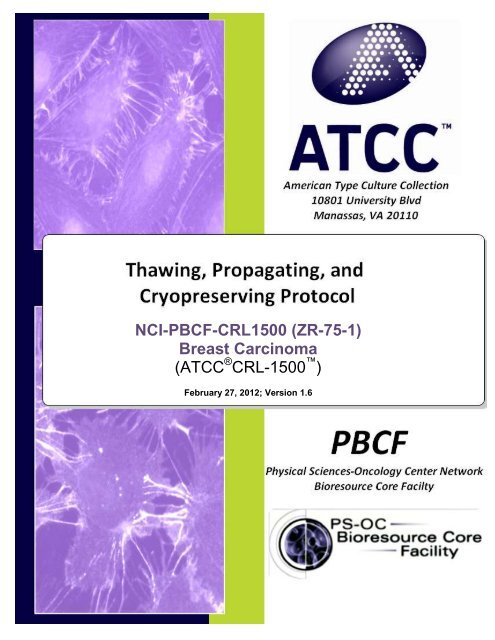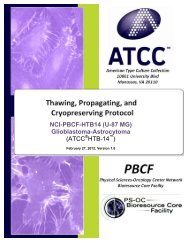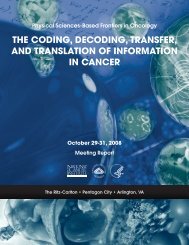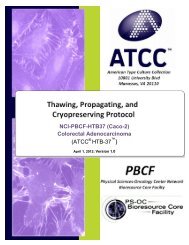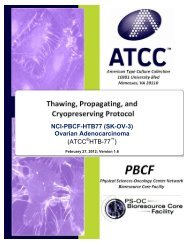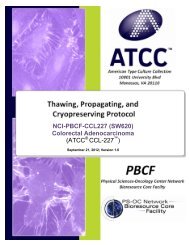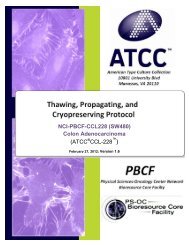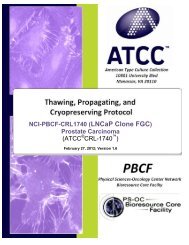ZR-75-1
ZR-75-1
ZR-75-1
You also want an ePaper? Increase the reach of your titles
YUMPU automatically turns print PDFs into web optimized ePapers that Google loves.
NCI-PBCF-CRL1500 (<strong>ZR</strong>-<strong>75</strong>-1)<br />
Breast Carcinoma<br />
(ATCC ® CRL-1500 )<br />
February 27, 2012; Version 1.6
Table of Contents<br />
1. BACKGROUND INFORMATION ON <strong>ZR</strong>-<strong>75</strong>-1 CELL LINE .......................................................... 3 <br />
2. GENERAL INFORMATION FOR THE THAWING, PROPAGATING AND CRYOPRESERVING<br />
OF NCI-PBCF- CRL1500 (<strong>ZR</strong>-<strong>75</strong>-1) ...................................................................................................... 3 <br />
3. REAGENTS .................................................................................................................................... 5 <br />
A. PREPARATION OF COMPLETE GROWTH MEDIUM (RPMI 1640 + 10 % (V/V) FBS) .............................. 5 <br />
4. THAWING AND PROPAGATION OF CELLS ............................................................................... 6 <br />
A. THAWING CELLS ............................................................................................................................ 6 <br />
B. PROPAGATING CELLS .................................................................................................................... 7 <br />
C. SUBCULTURING CELLS ................................................................................................................... 8 <br />
5. HARVESTING OF CELLS FOR CRYOPRESERVATION ............................................................. 9 <br />
6. CRYOPRESERVATION OF CELLS ............................................................................................ 11<br />
A. CRYOPRESERVATION USING A RATE-CONTROLLED PROGRAMMABLE FREEZER ................................ 11<br />
i. Using the Cryomed ............................................................................................................... 11<br />
B. CRYOPRESERVATION USING “MR. FROSTY” .................................................................................. 12<br />
7. STORAGE .................................................................................................................................... 13<br />
APPENDIX 1: PHOTOMICROGRAPHS OF NCI-PBCF-CRL1500 (<strong>ZR</strong>-<strong>75</strong>-1) CELLS. ..................... 14<br />
APPENDIX 2: GROWTH PROFILE OF NCI-PBCF-CRL1500 (<strong>ZR</strong>-<strong>75</strong>-1) CELLS. ............................ 16<br />
APPENDIX 3: CYTOGENETIC ANALYSIS OF NCI-PBCF-CRL1500 <strong>ZR</strong>-<strong>75</strong>-1 CELLS ................... 17<br />
APPENDIX 4: GLOSSARY OF TERMS ............................................................................................. 20<br />
APPENDIX 5: REFERENCE ............................................................................................................... 21<br />
APPENDIX 6: REAGENT LOT TRACEABILITY AND CELL EXPANSION TABLES ...................... 22<br />
APPENDIX 7: CALCULATION OF POPULATION DOUBLING LEVEL (PDL) ................................ 24<br />
APPENDIX 8: SAFETY PRECAUTIONS ........................................................................................... 24
SOP: Thawing, Propagation and Cryopreservation of NCI-PBCF-CRL1500<br />
(<strong>ZR</strong>-<strong>75</strong>-1)<br />
Protocol for Thawing, Propagating and Cryopreserving of<br />
NCI-PBCF-CRL1500 (<strong>ZR</strong>-<strong>75</strong>-1; ATCC ® CRL-1500 ) cells<br />
breast carcinoma<br />
1. Background Information on <strong>ZR</strong>-<strong>75</strong>-1 cell line<br />
Designations:<br />
<strong>ZR</strong>-<strong>75</strong>-1<br />
Biosafety Level: 1<br />
Shipped:<br />
frozen (in dry ice)<br />
Growth Properties: adherent (See appendix 1)<br />
Organism:<br />
Homo sapiens<br />
Organ<br />
Source:<br />
Disease<br />
Derived from metastatic<br />
site:<br />
mammary gland; breast<br />
ductal carcinoma<br />
ascites<br />
For more information visit the ATCC webpage:<br />
http://www.atcc.org/ATCCAdvancedCatalogSearch/ProductDetails/tabid/452/Default.aspx?A<br />
TCCNum=CRL-1500&Template=cellBiology<br />
2. General Information for the thawing, propagating and<br />
cryopreserving of NCI-PBCF- CRL1500 (<strong>ZR</strong>-<strong>75</strong>-1)<br />
Culture Initiation<br />
Complete growth<br />
medium<br />
Cell Growth<br />
<br />
<br />
<br />
<br />
<br />
<br />
<br />
The cryoprotectant (DMSO) should be removed by centrifugation.<br />
The seeding density to use with a vial of <strong>ZR</strong>-<strong>75</strong>-1 cells is about 5 x 10 4 viable<br />
cells/cm 2 or one vial into a T-25 flask containing 10 mL of complete growth<br />
medium (RPMI 1640 + 10% (v/v) FBS).<br />
The complete growth medium used to expand <strong>ZR</strong>-<strong>75</strong>-1 cells is RPMI 1640 + 10%<br />
(v/v) FBS.<br />
Complete growth medium (RPMI 1640 + 10% (v/v) FBS) should be pre-warmed<br />
before use by placing into a water bath set at 35 o C to 37 o C for 15 min to 30 min.<br />
After 30 min, the complete growth medium (RPMI 1640 + 10% (v/v) FBS) should<br />
be moved to room temperature until used. Complete growth medium should be<br />
stored at 2 o C to 8 o C when not in use.<br />
The growth temperature for <strong>ZR</strong>-<strong>75</strong>-1 is 37 o C ± 1 o C.<br />
A 5 % + 1 % CO 2 in air atmosphere is recommended.<br />
Growth Prosperities Population doubling time (PDT) is approximately 54 h (Figure 4).<br />
Special Growth<br />
Requirements<br />
<br />
Subculture <strong>ZR</strong>-<strong>75</strong>-1 cells at 80 % to 90 % confluence or when cell density<br />
reaches an average of 4 x 10 5 viable cells/cm 2 .<br />
Page 3 of 24
SOP: Thawing, Propagation and Cryopreservation of NCI-PBCF-CRL1500<br />
(<strong>ZR</strong>-<strong>75</strong>-1)<br />
Subculture Medium<br />
Subculture Method<br />
Viable<br />
Cells/mL/Cryovial<br />
Cryopreservation<br />
Medium<br />
<br />
<br />
<br />
<br />
<br />
<br />
<br />
<br />
0.25 % (w/v) trypsin-0.53 mM EDTA (ATCC cat no. 30-2101).<br />
Subculturing reagents should be pre-warmed before use by placing into a water<br />
bath set at 35 o C to 37 o C for 15 min to 30 min.<br />
After 30 min, the subculturing medium should be moved to room temperature<br />
until used. Subculturing reagents should be stored at 2 o C to 8 o C when not in<br />
use.<br />
The attached <strong>ZR</strong>-<strong>75</strong>-1 cells are subcultured using 0.25 % (w/v) trypsin-0.53 mM<br />
EDTA (ATCC cat no. 30-2101).<br />
The enzymatic action of the trypsin-EDTA is stopped by adding complete growth<br />
medium to the detached cells.<br />
A split ratio of 1:8 to 1:10 or a seeding density of 4 x 10 4 viable cells/cm 2 to 5 x<br />
10 4 viable cells/cm 2 is used when subculturing <strong>ZR</strong>-<strong>75</strong>-1 cells.<br />
The target number of viable cells/mL/cryovial is: 2 x 10 6 (acceptable range: 2 x<br />
10 6 cells/mL to 3 x 10 6 cells/mL).<br />
The cryopreservation medium for <strong>ZR</strong>-<strong>75</strong>-1 cells is complete growth medium<br />
(RPMI 1640 + 10% (v/v) FBS) containing 5 % (v/v) DMSO (ATCC cat no. 4-X).<br />
General Procedure to be applied throughout the SOP<br />
Aseptic Technique<br />
Traceability of<br />
material/reagents<br />
Expansion of cell line<br />
<br />
<br />
<br />
Use of good aseptic technique is critical. Any materials that are contaminated,<br />
as well as any materials with which they may have come into contact, must be<br />
disposed of immediately.<br />
Record the manufacturer, catalog number, lot number, date received, date<br />
expired and any other pertinent information for all materials and reagents used.<br />
Record information in the Reagent Lot Traceability Table 4 (Appendix 6).<br />
Record the subculture and growth expansion activities, such as passage number,<br />
% confluence, % viability, cell morphology (see Figures 1, 2, 3 Appendix 1) and<br />
population doubling levels (PDLs), in the table for Cell Expansion (Table 5,<br />
Appendix 6). Calculate PDLs using the equation in Appendix 7.<br />
Medium volumes Medium volumes are based on the flask size as outlined in Table 1.<br />
Glossary of Terms<br />
Safety Precaution<br />
<br />
<br />
Refer to Glossary of Terms used throughout the document (see Appendix 4).<br />
Refer to Safety Precautions pertaining to the thawing, propagating and<br />
cryopreserving of <strong>ZR</strong>-<strong>75</strong>-1 (See Appendix 8).<br />
Page 4 of 24
SOP: Thawing, Propagation and Cryopreservation of NCI-PBCF-CRL1500<br />
(<strong>ZR</strong>-<strong>75</strong>-1)<br />
Table 1: Medium Volumes<br />
Flask Size<br />
Medium Volume Range<br />
12.5 cm 2 (T-12.5) 3 mL to 6 mL<br />
25 cm 2 (T-25) 5 mL to 13 mL<br />
<strong>75</strong> cm 2 (T-<strong>75</strong>) 10 mL to 38 mL<br />
150 cm 2 (T-150) 30 mL to <strong>75</strong> mL<br />
1<strong>75</strong> cm 2 (T-1<strong>75</strong>) 35 mL to 88 mL<br />
225 cm 2 (T-225) 45 mL to 113 mL<br />
3. Reagents<br />
Follow Product Information Sheet storage and/or thawing instructions. Below is a list of<br />
reagents for the propagation, subcultivation and cryopreservation of <strong>ZR</strong>-<strong>75</strong>-1 cells.<br />
Table 2: Reagents for Expansion, Subculturing and Cryopreservation<br />
of <strong>ZR</strong>-<strong>75</strong>-1 cells<br />
Complete growth Subculturing reagents Cryopreservation medium<br />
medium reagents<br />
reagents<br />
RPMI 1640 Medium<br />
(ATCC cat no. 30-2001)<br />
Trypsin-EDTA (0.25 % (w/v)<br />
Trypsin/0.53 mM EDTA )<br />
(ATCC cat no.30-2101)<br />
RPMI 1640 Medium<br />
(ATCC cat no. 30-2001)<br />
10 % (v/v) Fetal Bovine<br />
Serum (FBS)<br />
(ATCC cat no. 30-2020)<br />
Dulbecco’s Phosphate Buffered<br />
Saline (DPBS); modified without<br />
calcium chloride and without<br />
magnesium chloride<br />
(ATCC cat no. 30-2200)<br />
10 % (v/v) FBS<br />
(ATCC cat no. 30-2020)<br />
5 % (v/v) Dimethyl Sulfoxide<br />
(DMSO)<br />
(ATCC cat no. 4-X)<br />
a. Preparation of complete growth medium (RPMI 1640 + 10 %<br />
(v/v) FBS)<br />
The complete growth medium is prepared by aseptically combining<br />
1. 56 mL FBS (ATCC cat no. 30-2020) to a 500 mL bottle of basal medium, RPMI 1640<br />
(ATCC cat no. 30-2001).<br />
2. Mix gently, by swirling.<br />
Page 5 of 24
SOP: Thawing, Propagation and Cryopreservation of NCI-PBCF-CRL1500<br />
(<strong>ZR</strong>-<strong>75</strong>-1)<br />
4. Thawing and Propagation of Cells<br />
Reagents and Material:<br />
Complete growth medium (RPMI 1640 + 10 % (v/v) FBS)<br />
Water bath<br />
T-25 cm 2 polystyrene flask <br />
15 mL polypropylene conical centrifuge tubes<br />
Plastic pipettes (1 mL,10 mL, 25 mL)<br />
a. Thawing cells<br />
Method:<br />
1. Place complete growth medium (RPMI 1640 + 10 % (v/v) FBS) in a water bath set at<br />
35 o C to 37 o C.<br />
2. Label T-25 flask to be used with the (a) name of cell line, (b) passage number, (c)<br />
date, (d) initials of technician.<br />
3. Wearing a full face shield, retrieve a vial of frozen cells from liquid nitrogen freezer.<br />
4. Thaw the vial by gentle agitation in a water bath set at 35 o C to 37 o C. To reduce the<br />
possibility of contamination, keep the O-ring and cap out of the water.<br />
Note: Thawing should be rapid (approximately 2 min to 3 min, just long enough<br />
for most of ice to melt).<br />
5. Remove vial from the water bath and process immediately.<br />
6. Remove excess water from the vial by wiping with sterile gauze saturated with 70 %<br />
ethanol.<br />
7. Transfer the vial to a BSL-2 laminar-flow hood.<br />
Page 6 of 24
SOP: Thawing, Propagation and Cryopreservation of NCI-PBCF-CRL1500<br />
(<strong>ZR</strong>-<strong>75</strong>-1)<br />
b. Propagating cells<br />
Method:<br />
1. Add 9 mL of complete growth medium (RPMI 1640 + 10 % (v/v) FBS) to a 15-mL<br />
conical centrifuge tube.<br />
2. Again wipe the outer surface of the vial with sterile gauze wetted with 70 % ethanol.<br />
3. Using sterile gauze, carefully remove the cap from the vial.<br />
4. With a 1 mL pipette transfer slowly the completely thawed content of the vial (1 mL<br />
cell suspension) to the 15-mL conical centrifuge tube containing 9 mL complete<br />
growth medium (RPMI 1640 + 10 % (v/v) FBS). Gently resuspend cells by pipetting<br />
up and down.<br />
5. Centrifuge at 125 xg, at room temperature, for 8 min to 10 min.<br />
6. Carefully aspirate (discard) the medium, leaving the pellet undisturbed.<br />
7. Using a 10 mL pipette, add 10 mL of complete growth medium (RPMI 1640 + 10 %<br />
(v/v) FBS).<br />
8. Resuspend pellet by gentle pipetting up and down.<br />
9. Using a 1 mL pipette, remove 1 mL of cell suspension for cell count and viability. Cell<br />
counts are performed using either an automated counter (such as Innovatis Cedex<br />
System; Beckman-Coulter ViCell system) or a hemocytometer.<br />
10. Record total cell count and viability. When an automated system is used, attach<br />
copies of the printed results to the record.<br />
11. Plate cells in pre-labeled T-25 cm 2 flask at about 5 x 10 4 viable cells/cm 2 .<br />
12. Transfer flask to a 37 °C ± 1 °C in 5 % CO 2 incubator if using flasks with vented caps<br />
(for non-vented caps stream 5 % CO 2 in the headspace of flask).<br />
13. Observe culture daily by eye and under an inverted microscope to ensure culture is<br />
free of contamination and culture has not reached confluence. Monitor, visually, the<br />
pH of the medium daily. If the medium goes from red through orange to yellow,<br />
change the medium.<br />
14. Note: In most cases, cultures at a high cell density exhaust the medium faster<br />
than those at low cell density as is evident from the change in pH. A drop in<br />
pH is usually accompanied by an increase in cell density, which is an indicator<br />
to subculture the cells. Cells may stop growing when the pH is between pH 7<br />
to pH 6 and loose viability between pH 6.5 and pH 6.<br />
15. If fluid renewal is needed, aseptically aspirate the complete growth medium from the<br />
flask and discard. Add an equivalent volume of fresh complete growth medium to<br />
the flask. Alternatively, perform a fluid addition by adding fresh complete growth<br />
medium to the flask without removing the existing medium. Record fluid change or<br />
fluid addition on the Cell Line Expansion Table (see Table 5 in Appendix 6).<br />
16. If subculturing of cells is needed, continue to ‘Subculturing cells’.<br />
Page 7 of 24
SOP: Thawing, Propagation and Cryopreservation of NCI-PBCF-CRL1500<br />
(<strong>ZR</strong>-<strong>75</strong>-1)<br />
Note: Subculture <strong>ZR</strong>-<strong>75</strong>-1 cells at 80 % to 90 % confluence or when cell density<br />
reaches an average of 4 x 10 5 viable cells/cm 2 (Appendix 1).<br />
c. Subculturing cells<br />
Reagents and Material:<br />
0.25 % (w/v) Trypsin-0.53 mM EDTA<br />
DPBS<br />
Complete growth medium (RPMI 1640 (ATCC cat no. 30-2001) + 10 % (v/v) FBS<br />
(ATCC cat no. 30-2020)<br />
Plastic pipettes (1 mL, 10 mL, 25 mL)<br />
T-<strong>75</strong> cm 2 , T-225 cm 2 polystyrene flasks<br />
Method:<br />
1. Aseptically remove medium from the flask<br />
2. Add appropriate volumes of sterile Ca 2+ - and Mg 2+ -free DPBS to the side of the flask<br />
opposite the cells so as to avoid dislodging the cells (see Table 3).<br />
3. Rinse the cells with DPBS (using a gently rocking motion) and discard.<br />
4. Add appropriate volume of 0.25 % (w/v) Trypsin-0.53 mM EDTA solution to the flask<br />
(see Table 3).<br />
5. Incubate the flask at 37 o C ± 1 °C until the cells round up. Observe cells under an<br />
inverted microscope every 5 min. When the flask is tilted, the attached cells should<br />
slide down the surface. This usually occurs after 5 min to 10 min incubation.<br />
Note: Do not leave trypsin-EDTA on the cells any longer than necessary as<br />
clumping may result.<br />
6. Neutralize the trypsin-EDTA/cells suspension by adding an equal volume of<br />
complete growth medium (RPMI 1640 + 10 % (v/v) FBS) to each flask. Disperse the<br />
cells by pipetting, gently, over the surface of the monolayer. Pipette the cell<br />
suspension up and down with the tip of the pipette resting on the bottom corner or<br />
edge until a single cell suspension is obtained. Care should be taken to avoid the<br />
creation of foam.<br />
7. Using a 1 mL pipette, remove 1 mL of cell suspension for total cell count and<br />
viability.<br />
8. Record total cell count and viability.<br />
9. Add appropriate volume of fresh complete growth medium (RPMI 1640 + 10 % (v/v)<br />
FBS) and transfer cell suspension (for volume see Table 1) into new pre-labeled<br />
flasks at a seeding density of 4.0 x 10 4 to 5.0 x 10 4 viable cells/cm 2 or a split ratio of<br />
1:8 to 1:10.<br />
10. Label all new flasks with the (a) name of cell line, (b) passage number, (c) date, (d)<br />
initials of technician.<br />
Page 8 of 24
SOP: Thawing, Propagation and Cryopreservation of NCI-PBCF-CRL1500<br />
(<strong>ZR</strong>-<strong>75</strong>-1)<br />
Table 3 - Volume of Rinse Buffer and Trypsin<br />
Flask<br />
Type<br />
Flask<br />
Size<br />
DPBS Rinse<br />
Buffer<br />
Trypsin-EDTA<br />
T-flask 12.5 cm 2 (T-12.5) 1 mL to 3 mL 1 mL to 2 mL<br />
25 cm 2 (T-25) 1 mL to 5 mL 1 mL to 3 mL<br />
<strong>75</strong> cm 2 (T-<strong>75</strong>) 4 mL to 15 mL 2 mL to 8 mL<br />
150 cm 2 (T-150) 8 mL to 30 mL 4 mL to 15 mL<br />
1<strong>75</strong> cm 2 (T-1<strong>75</strong>) 9 mL to 35 mL 5 mL to 20 mL<br />
225 cm 2 (T-225) 10 mL to 45 mL 5 mL to 25 mL<br />
5. Harvesting of Cells for Cryopreservation<br />
Reagents and Material:<br />
0.25 % (w/v)Trypsin-0.53 mM EDTA<br />
DPBS<br />
Complete growth medium (RPMI 1640 (ATCC cat no. 30-2001) + 10 % (v/v) FBS<br />
(ATCC cat no. 30-2020))<br />
50 mL or 250 mL conical centrifuge tube<br />
Plastic pipettes (1 mL, 10 mL, 25 mL)<br />
Sterile DMSO<br />
1 mL to 1.8 mL cryovials<br />
Ice bucket with ice<br />
Method:<br />
1. Label cryovials to include information on the (a) name of cell line, (b) passage<br />
number (c) date.<br />
2. Prepare cryopreservation medium by adding DMSO to cold complete growth medium<br />
(RPMI 1640 + 10 % (v/v) FBS) at a final concentration of 5 % (v/v) DMSO. Place<br />
cryopreservation medium on ice until ready to use.<br />
3. Aseptically remove medium from the flask(s).<br />
4. Add appropriate volumes of sterile Ca 2+ - and Mg 2+ -free DPBS to the side of the flask<br />
so as to avoid dislodging the cells (see Table 3).<br />
5. Rinse the cells with DPBS (using a gentle rocking motion) and discard.<br />
6. Add appropriate volume of 0.25 % (w/v) Trypsin-0.53 mM EDTA solution to the flask<br />
(see Table 3).<br />
Page 9 of 24
SOP: Thawing, Propagation and Cryopreservation of NCI-PBCF-CRL1500<br />
(<strong>ZR</strong>-<strong>75</strong>-1)<br />
7. Incubate the flask at 37 o C ± 1 °C until the cells round up. Observe cells under an<br />
inverted microscope every 5 min. When the flask is tilted, the attached cells should<br />
slide down the surface. This usually occurs after 5 min to 10 min of incubation.<br />
Note: Do not leave trypsin-EDTA on the cells any longer than necessary as<br />
clumping may result.<br />
8. Neutralize the trypsin-EDTA/cell suspension by adding an equal volume of complete<br />
growth medium (RPMI 1640 + 10 % (v/v) FBS) to each flask. Disperse the cells by<br />
pipetting, gently, over the surface of the monolayer. Pipette the cell suspension up<br />
and down with the tip of the pipette resting on the bottom corner or edge until a<br />
single cell suspension is obtained. Care should be taken to avoid the creation of<br />
foam.<br />
9. Using a 1 mL pipette, remove 1 mL of cell suspension for total cell count and<br />
viability.<br />
10. Record total cell count and viability.<br />
11. Spin cells at approximately 125 xg for 5 min to 10 min at room temperature.<br />
Carefully aspirate and discard the medium, leaving the pellet undisturbed<br />
12. Calculate volume of cryopreservation medium based on the count performed at<br />
step 9 and resuspend pellet in cold cryopreservation medium at a viable cell density<br />
of 2 x 10 6 viable cells/mL (acceptable range: 2 x 10 6 viable cells/mL to 3 x 10 6 viable<br />
cells/mL).<br />
13. Dispense 1 mL of cell suspension, using a 5 mL or 10 mL pipette, into each 1.0 mL<br />
cryovial.<br />
14. Place filled cryovials at 2 o C to 8 o C until ready to cryopreserve. A minimum<br />
equilibration time of 10 min but no longer than 45 min is necessary to allow DMSO to<br />
penetrate the cells.<br />
Note: DMSO is toxic to the cells. Long exposure in DMSO may affect viability.<br />
Page 10 of 24
SOP: Thawing, Propagation and Cryopreservation of NCI-PBCF-CRL1500<br />
(<strong>ZR</strong>-<strong>75</strong>-1)<br />
6. Cryopreservation of Cells<br />
Material:<br />
Liquid nitrogen freezer<br />
Cryomed Programmable freezer (Forma Scientific, catalog no. 1010) or<br />
Mr. Frosty (Nalgene, catalog no. 5100)<br />
Isopropanol<br />
Cryovial rack<br />
<br />
a. Cryopreservation using a rate-controlled programmable freezer<br />
Method:<br />
A slow and reproducible cooling rate is very important to ensure good recovery of<br />
cultures. A decrease of 1 °C per min to -80 °C followed by rapid freeze at about 15 °C to<br />
30 °C per min drop to -150 °C will usually work for most animal cell cultures. The best<br />
way to control the cooling process is to use a programmable, rate-controlled, electronic<br />
freezer unit. Refer to the manufacturer’s handbook for detailed procedure.<br />
i. Using the Cryomed<br />
Starting the Cryopreservation Process<br />
1. Check that the liquid nitrogen valve that supplies the Cryomed is open.<br />
2. Check the gauge to ensure that there is enough liquid nitrogen in the open tank to<br />
complete the freeze.<br />
3. Install the thermocouple probe so that the tip is immersed midway into the control<br />
fluid<br />
Note: Be sure that the thermocouple is centered in the vial and the vial is<br />
placed centered in the rack. The probe should be changed after three uses or<br />
if it turns yellow to ensure accurate readings by the controller during the<br />
freezing process. Old medium may have different freezing characteristics.<br />
4. Close and latch Cryomed door.<br />
5. Turn on microcomputer, computer and monitor.<br />
6. Double click the “Cryomed” icon. The machine may need to be pre-programmed for<br />
specific cell type and medium.<br />
Page 11 of 24
SOP: Thawing, Propagation and Cryopreservation of NCI-PBCF-CRL1500<br />
(<strong>ZR</strong>-<strong>75</strong>-1)<br />
7. From the top of the screen, select MENU RUN FUNCTIONS START RUN.<br />
8. Fill out the box which appears on the screen. Cell line ID; TYPE OF SAMPLE;<br />
MEDIA; NUMBER OF SAMPLES.<br />
9. Hit the ESCAPE key and the Cryomed will cool to 4C.<br />
10. Once Cryomed chamber has cooled to 4C, load cryovials onto racks and close the<br />
door.<br />
11. When the Cryomed’s chamber temperature and the sample temperature have<br />
reached approximately 4 C; press the space bar to initiate the rate controlled<br />
cryopreservation process.<br />
Completing the Cryopreservation Process<br />
1. When samples have reached -80C, an alarm will sound. To silence this, select<br />
ALARM from the options at the top of the screen.<br />
2. Select MENU RUN FUNCTIONS→ STOP. Hit the ESCAPE key to return to the<br />
main menu and select EXIT.<br />
3. Immediately transfer vials to liquid nitrogen freezer.<br />
4. Shut down the microcomputer and then turn off the monitor.<br />
b. Cryopreservation using “Mr. Frosty”<br />
1. One day before freezing cells, add 250 mL isopropanol to the bottom of the container<br />
and place at 2 o C to 8 o C.<br />
2. On the day of the freeze, prepare cells for cryopreservation as described above.<br />
3. Insert cryovials with the cell suspension in appropriate slots in the container.<br />
4. Transfer the chamber to a -70 °C to -90 °C freezer and store overnight.<br />
5. Next day, transfer cryovials to the vapor phase of liquid nitrogen freezer.<br />
Note: Each container has 18 slots which can accommodate 18 cryovials in one<br />
freeze.<br />
Page 12 of 24
SOP: Thawing, Propagation and Cryopreservation of NCI-PBCF-CRL1500<br />
(<strong>ZR</strong>-<strong>75</strong>-1)<br />
Important information when using the rate-controlled programmable freezer or a<br />
manual method (Mr. Frosty) for cryopreservation of mammalian cells.<br />
Regardless which cooling method is used, it is important that the transfer to the final<br />
storage location (between -130 °C and -196 °C) be done quickly and efficiently. If the<br />
transfer cannot be done immediately, the vials can be placed on dry ice for a short<br />
time. This will avoid damage to cultures by inadvertent temporary warming during the<br />
transfer process. Warming during this transfer process is a major cause of variation<br />
in culture viability upon thawing.<br />
Always keep the storage temperature below -130 °C for optimum survival. Cells may<br />
survive storage at higher temperatures but viability will usually decrease over time.<br />
The ideal storage container is a liquid nitrogen freezer where the cultures are stored<br />
in the vapor phase above the liquid nitrogen.<br />
Note: ATCC does not have experience in the cryopreservation of the <strong>ZR</strong>-<strong>75</strong>-1 cells<br />
by any other method than the Cryomed programmable freezer.<br />
7. Storage<br />
Store cryopreserved cells in the vapor phase of liquid nitrogen freezer (below –130<br />
°C) for optimum long-term survival.<br />
Note: Experiments on long-term storage of animal cell lines at different<br />
temperature levels indicate that a -70 °C storage temperature is not adequate<br />
except for very short period of time. A -90 °C storage may be adequate for longer<br />
periods depending upon the cell line preserved. The efficiency of recovery,<br />
however, is not as great as when the cells are stored in vapor phase of the liquid<br />
nitrogen freezer.<br />
Page 13 of 24
SOP: Thawing, Propagation and Cryopreservation of NCI-PBCF-CRL1500<br />
(<strong>ZR</strong>-<strong>75</strong>-1)<br />
APPENDIX 1: PHOTOMICROGRAPHS OF NCI-PBCF-CRL1500 (<strong>ZR</strong>-<strong>75</strong>-1) CELLS.<br />
Figure 1: Photomicrograph of <strong>ZR</strong>-<strong>75</strong>-1 cells after one day, post-freeze<br />
recovery. Cells were plated at 9 x 10 4 viable cells/cm 2 .<br />
Figure 2: Photomicrograph of <strong>ZR</strong>-<strong>75</strong>-1 cells after four days, post-freeze<br />
recovery. Cells were plated at 9 x 10 4 viable cells/cm 2 .<br />
Page 14 of 24
SOP: Thawing, Propagation and Cryopreservation of NCI-PBCF-CRL1500<br />
(<strong>ZR</strong>-<strong>75</strong>-1)<br />
40X 40X 40X<br />
500 µm<br />
500 µm<br />
500 µm<br />
100X 100X 100X<br />
200 µm 200 µm 200 µm<br />
Figure 3: Photomicrographs of <strong>ZR</strong>-<strong>75</strong>-1 cells at various time points after<br />
seeding at a cell density of 5 x 10 4 viable cells/cm 2 .<br />
Page 15 of 24
SOP: Thawing, Propagation and Cryopreservation of NCI-PBCF-CRL1500<br />
(<strong>ZR</strong>-<strong>75</strong>-1)<br />
APPENDIX 2: GROWTH PROFILE OF NCI-PBCF-CRL1500 (<strong>ZR</strong>-<strong>75</strong>-1) CELLS.<br />
7.00E+05<br />
6.00E+05<br />
5.00E+05<br />
Viable Cells/cm 2<br />
4.00E+05<br />
3.00E+05<br />
2.00E+05<br />
1.00E+05<br />
0.00E+00<br />
0 2 4 6 8 10 12<br />
Days in Culture<br />
Figure 4: Growth curve for <strong>ZR</strong>-<strong>75</strong>-1 cells; cells were plated at 5 x 10 4 viable<br />
cells/cm 2 ; population doubling time (PDT) is approximately 54 h.<br />
Page 16 of 24
SOP: Thawing, Propagation and Cryopreservation of NCI-PBCF-CRL1500<br />
(<strong>ZR</strong>-<strong>75</strong>-1)<br />
APPENDIX 3: CYTOGENETIC ANALYSIS OF NCI-PBCF-CRL1500 <strong>ZR</strong>-<strong>75</strong>-1 CELLS<br />
NCI-PBCF-CRL1500 Karyotype Results<br />
Metaphase Spread<br />
Karyotype<br />
Number of metaphase spreads counted 20<br />
Band level 300-400<br />
Number of metaphase spreads karyotyped 10<br />
Chromosome range 69-<strong>75</strong><br />
Sex<br />
Comments<br />
Female<br />
Aneuploid*<br />
Karyotype:<br />
69-<strong>75</strong>,XXX,-1,del(6)(q21)x2,+add(8)(p10),inv(9)(p13q12),der(10)t(10;15)(q10;q10),-11,<br />
der(11)t(11;17)(p15;q11.2)x2,-13,add(14)(q32),der(15)t(11;15)(q13;p11.2),-16,<br />
add(17)(p11.2),-20,-21,-22,+mar1,+mar2,+mar3x2-3,+mar4,+mar5,+mar6<br />
(ISCN nomenclature written based on a triploid karyotype).<br />
*Human diploid karyotype (2N): 46,XX (female) or 46,XY (male)<br />
Page 17 of 24
SOP: Thawing, Propagation and Cryopreservation of NCI-PBCF-CRL1500<br />
(<strong>ZR</strong>-<strong>75</strong>-1)<br />
Karyotype Summary:<br />
In the karyotype image, arrows indicate regions of abnormality. It should be noted that the<br />
karyotype description includes the observed abnormalities from all examined metaphase<br />
spreads, but due to heterogeneity, not all of the karyotyped cells will contain every<br />
abnormality.<br />
This is a highly rearranged human cell line of female origin containing 69 to <strong>75</strong><br />
chromosomes per metaphase spread (hypertriploid). Structural abnormalities include<br />
rearrangements to chromosomes 6, 8, 9, 10, 11, 14, 15, and 17. There are six<br />
unidentifiable clonal marker chromosomes (markers present in two or more of the examined<br />
cells) [+mar1, +mar2, +mar3x2-3, +mar4, +mar5, +mar6].<br />
The rearrangements include:<br />
Addition of unknown material to the short arms (designated by p) of chromosomes 8<br />
and 17;<br />
Addition of unknown material to the long arm (designated by q) of chromosome 14;<br />
Deletion of material from the short arm of chromosome 6;<br />
Translocations involving chromosomes 10 and 15 [der(10)t(10;15)(q10;q10)], 11 and<br />
17 [der(11)t(11;17)(p15;q11.2)], and chromosomes 11 and 15<br />
[der(15)t(11;15)(q13;p11.2)];<br />
There is an inversion of chromosome 9 involving the chromosomal material between<br />
the short arm at band 13 and the long arm at band 12 [inv(9)(p13q12)].<br />
Numerical changes are based on a triploid karyotype which would contain three copies of<br />
each chromosome (3N). Therefore, karyotype designations such as -21,-22, indicate two<br />
copies each of structurally normal chromosomes 21 and 22. (ISCN 2009: An International<br />
System for Human Cytogenetic Nomenclature (2009), Editors: Lisa G. Shaffer, Marilyn L.<br />
Slovak, Lynda J. Campbell)<br />
Karyotype Procedure:<br />
Cell Harvest: Cells were allowed to grow to 80-90% confluence. Mitotic division was<br />
arrested by treating the cells with KaryoMax® colcemid for 20 minutes to 2 hours at 37°C.<br />
Cells were harvested using 0.05% Trypsin-EDTA, treated with 0.0<strong>75</strong>M KCL hypotonic<br />
solution, and then fixed in three changes of a 3:1 ratio of methanol;glacial acetic acid.<br />
Slide Preparation: Slides were prepared by dropping the cell suspension onto wet glass<br />
slides and allowing them to dry under controlled conditions.<br />
G-banding: Slides were baked one hour at 90°C, trypsinized using 10X trypsin-EDTA,<br />
and then stained with Leishman’s stain.<br />
Page 18 of 24
SOP: Thawing, Propagation and Cryopreservation of NCI-PBCF-CRL1500<br />
(<strong>ZR</strong>-<strong>75</strong>-1)<br />
Microscopy: Slides were scanned using a 10X objective and metaphase spreads were<br />
analyzed using a 100X plan apochromat objective on an Olympus BX-41 microscope.<br />
Imaging and karyotyping were performed using Cytovision® software.<br />
Analysis: Twenty metaphase cells were counted and analyzed, and representative<br />
metaphase cells were karyotyped depending on the complexity of the study.<br />
Summary of Karyotyping Procedure:<br />
G-band karyotyping analysis is performed using GTL banding technique: G bands produced<br />
with trypsin and Leishman. Slides prepared with metaphase spreads are treated with trypsin<br />
and stained with Leishman’s. This method produces a series of light and dark bands that<br />
allow for the positive identification of each chromosome.<br />
<strong>ZR</strong>-<strong>75</strong>-1 karyotyping was carried out by Cell Line Genetics, Inc. (Madison, WI 53719)<br />
Page 19 of 24
SOP: Thawing, Propagation and Cryopreservation of NCI-PBCF-CRL1500<br />
(<strong>ZR</strong>-<strong>75</strong>-1)<br />
APPENDIX 4: GLOSSARY OF TERMS<br />
Confluent monolayer: adherent cell culture in which all cells are in contact with other cells<br />
all around their periphery and no available substrate is left uncovered.<br />
Split ratio: the divisor of the dilution ration of a cell culture to subculture (e.g., one flask<br />
divided into four, or 100 mL up to 400 mL, would be split ratio of 1:4).<br />
Subculture (or passage): the transfer or transplantation of cells, with or without dilution,<br />
from one culture vessel to another.<br />
Passage No: the total number of times the cells in the culture have been subcultured or<br />
passaged (with each subculture the passage number increases by 1).<br />
Population doubling level (PDL): the total number of population doublings of a cell line<br />
since its initiation in vitro (with each subculture the population doubling increases in<br />
relationship to the split ratio at which the cells are plated). See Appendix 7.<br />
Population doubling time (doubling time): the time interval, calculated during the<br />
logarithmic phase of growth in which cells double in number.<br />
Seeding density: recommended number of cells per cm 2 of substrate when inoculating a<br />
new flask.<br />
Epithelial-like: adherent cells of a polygonal shape with clear, sharp boundaries between<br />
them.<br />
Fibroblast-like: adherent cells of a spindle or stellate shape.<br />
Page 20 of 24
SOP: Thawing, Propagation and Cryopreservation of NCI-PBCF-CRL1500<br />
(<strong>ZR</strong>-<strong>75</strong>-1)<br />
APPENDIX 5: REFERENCE<br />
1. Culture Of Animal Cells: A Manual of Basic Technique by R. Ian Freshney, 6th edition,<br />
published by Wiley-Liss, N.Y., 20105.<br />
2. 1230: Engel LW, Young NA. Human breast carcinoma cells in continuous culture: a<br />
review. Cancer Res. 38: 4327-4339, 1978. PubMed: 212193<br />
3. 23031: Engel LW, et al. Establishment and characterization of three new continuous cell<br />
lines derived from human breast carcinomas. Cancer Res. 38: 3352-3364, 1978.<br />
PubMed: 688225<br />
4. 23102: Dahiya R, et al. Mucin synthesis and secretion in various human epithelial cancer<br />
cell lines that express the MUC-1 mucin gene. Cancer Res. 53: 1437-1443, 1993.<br />
PubMed: 8443822<br />
5. 25065: Bellet D, et al. Malignant transformation of nontrophoblastic cells is associated<br />
with the expression of chorionic gonadotropin beta genes normally transcribed in<br />
trophoblastic cells. Cancer Res. 57: 516-523, 1997. PubMed: 9012484<br />
6. 32268: Couillard S, et al. Comparison of the effects of the antiestrogens EM-800 and<br />
tamoxifen on the growth of human breast <strong>ZR</strong>-<strong>75</strong>-1 cancer xenografts in nude mice.<br />
Cancer Res. 58: 60-64, 1998. PubMed: 9426058<br />
7. 32273: Wang E, et al. Posttranscriptional regulation of protein expression in human<br />
epithelial carcinoma cells by adenine-uridine-rich elements in the 3'-untranslated region<br />
of tumor necrosis factor-alpha messenger RNA. Cancer Res. 57: 5426-5433, 1997.<br />
PubMed: 9393771<br />
8. 322<strong>75</strong>: Littlewood-Evans AJ, et al. The osteoclast-associated protease cathepsin K is<br />
expressed in human breast carcinoma. Cancer Res. 57: 5386-5390, 1997. PubMed:<br />
9393764<br />
9. 32288: Landers JE, et al. Translational enhancement of mdm2 oncogene expression in<br />
human tumor cells containing a stabilized wild-type p53 protein. Cancer Res. 57: 3562<br />
3568, 1997. PubMed: 9270029<br />
10. 32341: Sheng S, et al. Maspin acts at the cell membrane to inhibit invasion and motility<br />
of mammary and prostatic cancer cells. Proc. Natl. Acad. Sci. USA 93: 11669-11674,<br />
1996. PubMed: 8876194<br />
Page 21 of 24
SOP: Thawing, Propagation and Cryopreservation of NCI-PBCF-CRL1500<br />
(<strong>ZR</strong>-<strong>75</strong>-1)<br />
APPENDIX 6: REAGENT LOT TRACEABILITY AND CELL EXPANSION TABLES<br />
Table 4: Reagent Lot Traceability<br />
Reagent Vendor Catalog # Lot # Expiration<br />
Date<br />
Page 22 of 24
Table 5: Cell Expansion<br />
FROM<br />
FLUID CHANGE<br />
Observation under<br />
microscope CELL COUNT TO<br />
By / Date<br />
Flask qty;<br />
size<br />
Pass # %<br />
Confluence<br />
Add/<br />
Replace<br />
Volume<br />
(in mL)<br />
Viable<br />
cells/mL<br />
Total<br />
viable<br />
cells<br />
%<br />
Viability<br />
Split<br />
Ratio<br />
Flask<br />
qty;<br />
size<br />
Pass #<br />
PDL#<br />
Add /<br />
Replace<br />
Add /<br />
Replace<br />
Add /<br />
Replace<br />
Add /<br />
Replace<br />
Add /<br />
Replace<br />
Add /<br />
Replace<br />
Add /<br />
Replace<br />
Add /<br />
Replace<br />
Add /<br />
Replace
SOP: Thawing, Propagation and Cryopreservation of NCI-PBCF-CRL1500<br />
<strong>75</strong>-1)<br />
(<strong>ZR</strong><br />
APPENDIX 7: CALCULATION OF POPULATION DOUBLING LEVEL (PDL)<br />
Calculate the PDL of the current passage using the following equation:<br />
PDL = X + 3.322 (log Y – log I)<br />
Where:<br />
X = initial PDL<br />
I = cell inoculum (number of cells plated in the flask)<br />
Y = final cell yield (number of cells at the end of the growth period)<br />
APPENDIX 8: SAFETY PRECAUTIONS<br />
Use at least approved Biological Safety Level 2 (BSL-2) facilities and procedures.<br />
Wear appropriate Personal Protective Equipment (PPE), such as isolation gown, lab coat<br />
with sleeve protectors, face shield and gloves.<br />
Use safety precautions when working with liquid nitrogen, nitrogen vapor, and cryogenically<br />
cooled fixtures.<br />
Use liquid nitrogen freezers and liquid nitrogen tanks only in areas with adequate ventilation.<br />
Liquid nitrogen reduces the concentration of oxygen and can cause suffocation.<br />
Wear latex gloves over insulating gloves to prevent liquid nitrogen from soaking in and being<br />
held next to the skin. Liquid nitrogen is extremely cold and will cause burns and frostbite.<br />
Metal inventory racks, tank components, and liquid nitrogen transfer hoses exposed to liquid<br />
nitrogen or nitrogen vapor quickly cool to cryogenic temperatures and can cause burns and<br />
frostbite.<br />
Wear a full face mask when thawing and retrieving vials from liquid nitrogen freezer. Danger<br />
to the technician derives mainly from the possibility that liquid nitrogen can penetrate the<br />
cryovial during storage. On warming, rapid evaporation of the nitrogen within the confines of<br />
such cryovial can cause an aerosol or explosion of the cryovial and contents.<br />
Page 24 of 24


